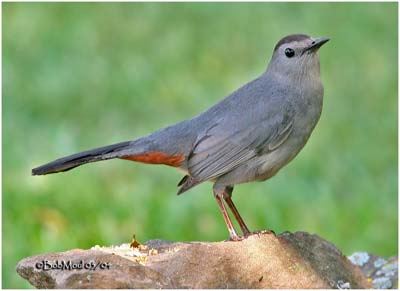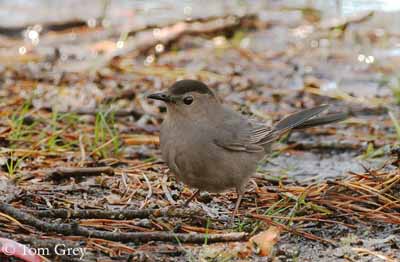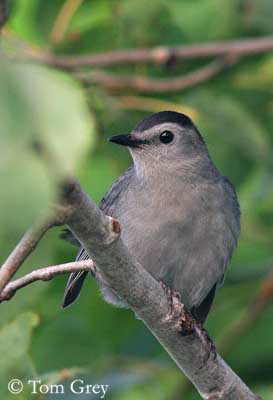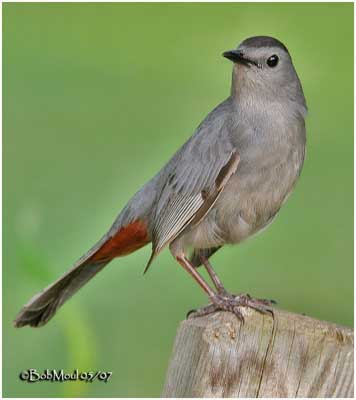
Grey Catbird
Dumetella carolinensis
Passeriforme Order – Mimidae Family
BIOMETRICS:
Length : 21-24 cm
Wingspan : 22-30 cm
Weight : 23-56 g
LONGIVITY: Up to 10 years
DESCRIPTION:
Grey Catbird has a combination of slate-grey plumage with black cap and tail, and chestnut undertail coverts. It has black bill, eyes, legs and feet.
Grey Catbird is much larger and darker than male Blackcap, and quite different in shape, with long, rounded tail often cocked, strong legs and prominent bill. Both sexes are similar.
Fr: Moqueur chat
All : Katzendrossel
Esp : Sinsonte Maullador
Ital : Uccello gatto testanera
Nd : Katvogel
Russe : Кошачий пересмешник
Sd : Grå kattfågel
Photos de Bob Moul
Son site:
Nature Photography
Photos de Tom Grey
Son site : Tom Grey's Bird Pictures
Texte de Nicole Bouglouan
Sources :
HANDBOOK OF THE BIRDS OF THE WORLD Vol 10 by Josep del Hoyo-Andrew Elliott-David Christie - Lynx Edicions - ISBN: 8487334725
FIELD GUIDE TO THE BIRDS OF NORTH AMERICA - National Geographic Society - ISBN: 0792274512
WRENS, DIPPERS AND THRASHERS by Brewer David – illustrated by Barry Kent Mackay- Yale University Press - ISBN: 0300090595
All About Birds (Cornell Lab of Ornithology)
Animal Diversity Web (University of Michigan Museum of Zoology)
What Bird-The ultimate Bird Guide (Mitchell Waite)
Wikipedia (Wikipedia, The Free Encyclopedia)

First winter has brownish tinge to flight feathers, primary coverts and sometimes, outer greater coverts. Eyes are greyish brown or dull reddish brown. Immature is similar to adult.
VOICE: SOUNDS BY XENO-CANTO
Grey Catbird has a characteristic call, a very short cat-like, nasal “mew”, slowing towards end. It has also a grating “tcheek-tcheek”, and a sharp snapping note. Song is a soft melodious warbling, interspersed with nasal mewing, squeaks and imitations. Grey Catbird can make more than 100 different types of sounds.
HABITAT:
Grey Catbird lives in dense thickets, especially near water, woodland edges, parks and residential areas, open woodlands with bushy undergrowth, and hedgerows, abandoned farmland and streamside.
RANGE:
Grey Catbird breeds across southern Canada, southward to N.E. Arizona and eastward to N. Florida.
It winters along East Coast from southern Massachusetts to Florida, and from the Gulf Coast southward into Central America and Caribbean.

BEHAVIOUR:
Grey Catbird male uses its loud song to proclaim its territory, using a softer version near the nest, or when there is an intruder. Female may sing the quiet song back to the male. Male may have two mates in different territories, and defends both of them.
Grey Catbirds are other hosts of Brown-headed Cowbirds, but Catbirds learn to recognize its own eggs, and the cowbird’s eggs. Mistakes are rare. They rarely return to the same breeding site in successive years.
To feed, Grey Catbird gleans insects off vegetation and from ground. They forage also in treetops.
Grey Catbird is diurnal and migratory, but they migrate at night. They flock in group of 10 to 15 birds. They communicate visually, with special attitudes of head and feathers. They also communicate by way of calls and songs. They have an unusual structure of their syrinx (a bird’s syrinx is a double instrument that sits deep in a bird’s chest at the point where the trachea divides into two bronchi) which allows both sides of it to operate independently. It means that they can sing with two voices at once.
Grey Catbird responds aggressively towards predators, flashing their wings and tail, and calling. They may attack and peck at predator near the nest.
FLIGHT:
Grey Catbird tends to fly low and for short distances from perch to perch. They don’t like to fly over wide or open spaces.

REPRODUCTION:
Grey Catbird’s nest is a bulky cup built by female. It’s located in dense shrubs, small trees and vines, low to the ground. The nest is made from twigs, scraps, paper or plastic, straw and mud. It’s lined with rootlets, fine grass or hair.
Female lays 1 to 5 turquoise-coloured eggs. Incubation lasts 12 to 14 days, by female, while the male stands guard nearly. It occasionally feeds its mate. Young hatch helpless and partially covered with dark down. Parents shade them in the nest, perched on the rim, with wings spread and breast feathers fluffed. Both parents feed young. They leave the nest at 10 to 11 days old, and parents continue to feed them for up to 12 days. They get their reproductive maturity at one year. Grey Catbirds often raise two broods a year, and build a new nest for each brood.
DIET:
Grey Catbirds are omnivorous. They eat primarily insects (ants, beetles, flies, caterpillars and moths) and spiders. They eat also fruits (blueberries and raspberries). Nestlings are fed insect food almost exclusively until before fledging, when fruit is introduced into their menu.

PROTECTION / THREATS / STATUS:
Grey Catbird’s nests are often parasitized by Brown-headed Cowbird. They have some predators too, such as snakes, foxes, rats, domestic cats, squirrels and chipmunks, raccoons, Blue Jays, American Crows and Common Grackles. They prey on catbird’s eggs and chicks.
Adult may be hunted by raptors such Red-tailed Hawk, Cooper’s Hawk and Peregrine Falcon.
Grey Catbird is a common species, but they seem to have become less common recently. Their habitat is destroyed by clearing fields for agriculture.
They are protected under the U.S. Migratory Bird Act.